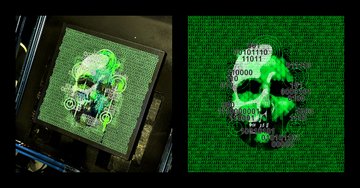
At first, we like to introduce the artist behind this amazing collection.

What makes this collection so special? – Embodies and synthesize a biochemical thought process – Combines Robotics, Blockchain AI and generative Art – Translates physical paintings into digital paintings – Try to reach emergence – 100% Onchain – 100% cool
Before we take a deeper look into the collection, let’s discuss the process. At its core, it attempts to synthesize and embody a biochemical thought process: creativity. Consider the underlying thought as what one can express and how one can express it.




His robotic system utilizes multimodal mark-making and feedback loops. Mark-making, for example, refers to the creation of different patterns, lines, textures, and shapes. It doesn’t matter if it’s on paper or digital; one can even draw in the sand. Mark-making is an important method in early childhood for children to express themselves and their feelings.


Feedback Loops: Now add feedback loops to mark-making. What’s special about Pindar’s feedback loops is that they are physically trained. A robotic arm paints on a canvas with the aid of installed cameras and responsive algorithms, allowing the system to reconsider the outcome and adjust the subsequent step.



Like a physical painting that consists of different layers, the system paints the first layer, “sees” the outcome, and reacts to the first layer with the next layer. A human artist does the same when they draw, take a step back, overthink it, adjust, and then proceed with the next drawing.

When you consider the various factors required by a human artist (environment, experience, tools, etc.), you realize a robotic system needs different elements (algorithms, tools, etc.). When all of these are combined, you get a creative thought process that responds to changes in real time to produce the final result.
Imagine Pindar in this process as a teacher for his systems, where he trains his “students” and guides them in the right direction. Initially, the training is much more necessary. Eventually, the “students” become more independent, and the outcomes improve.

You could argue that humans are far more creative, and you’d be right. But even a human is merely the product of their education, environment, friends, teachers, and so on. The question with humans and increasingly with AI is, what process is deterministic and what process is emergent.
The interplay between painting and thinking is the reason the collection is called Reflection. A really cool fact about this collection is that the physical process is replicated digitally. It is also possible to reverse this process and physically replicate the digital work of art layer by layer.

If you take a closer look at this piece, you will see the different layers and the complexity behind it.


Background: A limitation of on-chain art is the file size. Everything looks pixelated, so it’s difficult to choose a background with a small file size. That’s the reason for the look of its minimalistic and aesthetic background style. Below are two examples.


You get different outcomes like the matrix-style more digital outcome, the monochrome outcome, and a more human outcome. Examples below.



In our opinion, this is one of the most interesting collections this year, if not ever.
The collection of 999 pieces was released on 7th February for 0.33 ETH each and sold out on his birthday, 8th February. For it, he partnered with @NFTParis, @SOVRN, and @FAB, presenting at Europe’s biggest web3 gathering.
We hope that we have enlightened you about the collection. Thank you for your time.



